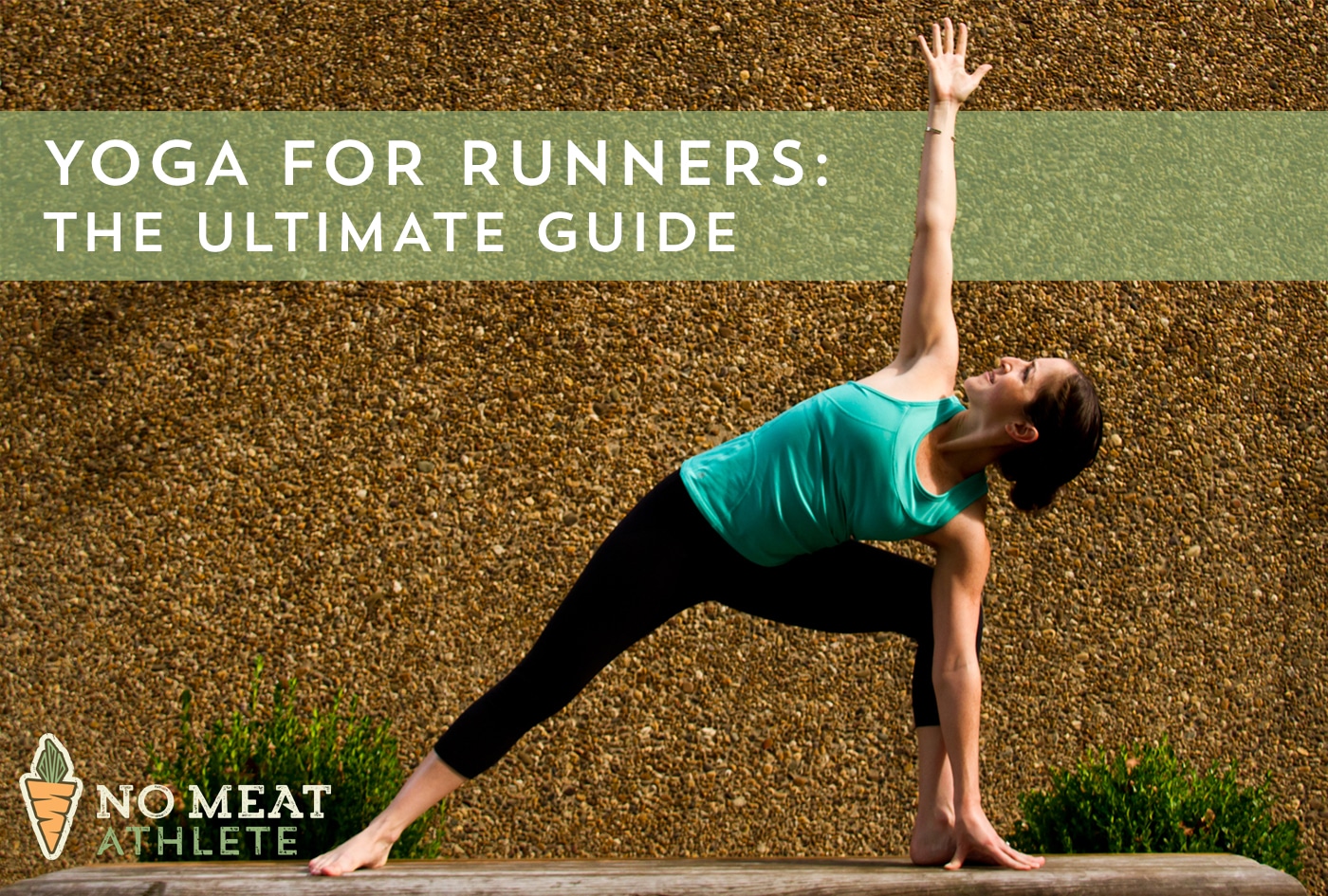
Yoga for Runners: The Ultimate Guide
Yoga, it’s everywhere.
It’s in our schools. It’s at our gyms. It’s even on NFL football fields.
But is it part of your training?
Yoga has exploded in popularity over the past several years, and yogis of all ages use their practice to gain physical strength, calm their minds, and work through life’s stresses.
As plant-based athletes and runners, yoga can be a major training tool to help both the mind and body, whether you’re training for a goal race or running to stay in shape.
How My Yoga Teacher Wife Changed My Running
Yoga is to my wife Katie as running is to me. It’s her way of staying healthy — both mentally and physically — and her escape from a hard day. It’s her meditation and platform for a good sweat.
And it shapes the way she lives her life. For example the yogic practice of ahimsa — or non-violence to all living things — is one of the main reasons she follows a vegetarian diet (I’m still working on her with that whole vegan thing …).
But when we started dating some six years ago, I didn’t get it.
I mean, I’m a trail runner. I like mud, rocks, and grunting my way up mountains … not group chants, twists, and something called mountain pose (which at the time looked to me like just standing).
Like I said, I didn’t get it.
Then, in an attempt to impress my new girlfriend, I went to a class … and it clicked.
My body felt refreshed and strong, and my mind reset.
It released areas of my body overworked from running, and strengthened many of my neglected muscles. And after a few injuries from recent marathon training cycles, yoga felt like just the tool my training had been missing.
Since that first class, Katie has gone on to become a 500 hour registered yoga teacher (RYT500) with a focus in yoga therapy, which means that every day she uses yoga to help someone work through a physical or mental ailment.
Many of those she teachers are runners, either fighting a recent injury or lingering overuse pain from years of pounding the pavement.
So when I sat down to write this post, I knew I had to tap into her experience and knowledge about using a regular yoga practice for better training. You’ll see her advice sprinkled in throughout the post, along with two classes designed for runners which you can find below.
6 Ways Runners Can Benefit from Yoga
The best cross-training activities provide benefits that we don’t get from a standard running workout. They work muscles and build strength in vulnerable or weak areas, and avoid over-stressing the mind or body.
Yoga does just that.
With help from Katie, here are a few of the most important ways yoga can help your training:
1. Yoga builds a stronger core.
A strong core reduces your risk of injury, keeps your running form in check, and helps prevent late-race fatigue.
Yoga provides a way to build strength of all the core muscles, including those that lay deep within the body that crunches and other core work often don’t reach.
2. Yoga brings flexibility.
It’s no secret that runners develop tight hips, glutes, quads, and hamstrings.
Yoga can help to open up chronically tight areas in runners created by the repetitive running stride.
A smart yoga routine gives your body time to warm up, moves into deeper stretches to create flexibility and muscle release, and finishes with gentle movement and a long rest to allow the body time to integrate the work you’ve done.
3. Yoga helps with breath.
There’s mixed thinking on whether rhythmic breathing, or breathing patterns, impact your running, but all runners can agree that more oxygen is a good thing.
The breath is a powerful tool, and in yoga the pranayama — or breath work — is a practice that will increase your oxygen intake, strengthen the breathing muscles, and teach you to breathe effectively.
Through yogic breath practice you will also benefit from a more relaxed mental state. Deep breathing can help reduce performance anxiety and allow you to better manage the mental intensity of training.
4. Yoga creates inner strength.
Runners only find success with a strong body and mind.
Contrary to what the modern yoga phenomenon may lead you to believe, yoga is not just about the physical postures. It’s also very much a mental practice. In yoga you cultivate improved concentration and the ability to overcome the ego; confidence is built on the yoga mat and transfers over when you’re lacing up for a race.
Yoga also teaches you to tune into your edge — that place where you’re pushing just enough but not too far — and how to tell the difference between intense sensation and pain signals.
5. Yoga facilitates better balance.
Runners, especially trail runners, need balance to stay upright and move efficiently, which is why I always recommend balance-specific exercises.
Certain balancing poses common in yoga build strength in your feet, ankles, knees and hips, and help establish your center of gravity.
6. Yoga aids in recovery.
One of the most neglected areas of training is proper recovery, which helps with injury prevention and steady training progress.
Like any good cross-training, yoga aids in recovery after a period of intense training or racing. It can help recover tired feet and legs, lessen mental fatigue, and reduce the time your body needs to get back on the road or trails.
How to Incorporate Yoga Into Your Training
Yoga is accessible to everyone. You don’t need special gear or skills, and you can practice it for 15 minutes after a run or for an hour and a half as a stand-alone workout.
For my running, I like to use yoga in two ways:
- To strengthen and stretch post-run, typically for 15-30 minutes
- For cross-training on off or low-mileage days, with a full-length class at a yoga studio
Keep in mind that on an off-day, it’s important that the yoga practice be easy and restorative. Rest days are essential for recovery, so even though yoga isn’t the same as running, a hard yoga class doesn’t count as rest.
You’ll find video examples of both options below.
What You Need to Get Started with Yoga
One of the beauties of yoga is that you don’t need much in the way of equipment, especially if you’re practicing at a studio. The studio will have or rent yoga mats, and provide anything else the teacher may wish to use.
But if you plan to practice on your own at home, there are a few things you may need.
I asked Katie for a list:
1. Mat: My favorites are Jade or Manduka mats, but cheaper mats work just fine, especially in the beginning.
2. Blocks: Important for the not-so-flexible runners in need of extra support.
3. Blanket: As a tool for supporting tight areas in certain poses.
4. Strap: Used to hold certain poses and maintain proper alignment.
There’s also plenty of yoga-specific clothing, but running clothes typically work just fine unless the stretchy yoga materials make you feel more comfortable. Women may also want yoga pants to cover up certain areas of our body, but Doug always sticks with his running shorts.
Where to Find Yoga
Alright, so we’ve convinced you to hit the mat. Now what?
The easiest place to start is in a studio. Here’s Katie with more advice:
Yoga may feel intimidating the first time you practice, so I don’t always recommend starting out on your own. Find a local studio with beginners or appropriate for beginners classes, and give it a shot. Ask the studio’s staff what classes they recommend for you. If you’re too timid (like Doug was), invite a friend along with you.
Booking a 1-on-1 session with a qualified teacher is also a great way to get individualized instruction and guidance. Plus it can make your first class less intimidating.
Once you get to the studio, let the teacher or person checking you in know that it’s your first time doing yoga. Also let them know of any pain or injuries you are dealing with.
You can even let them know you are a runner so that they have in mind what your body will benefit from. That way the teacher will help adjust or offer extra cues throughout the class, tailoring it to your needs.
For a cheaper option you can find yoga sequence videos online, like the one included below.
My favorite website for yoga classes of all levels is Yoga Glo. They offer a monthly membership that’s cheaper than many one-off classes at a studio. Just remember, you won’t get adjustments or support real-time from a teacher. Mix in-person classes and at-home practice to prevent injury.
But the most important thing is to just give it a shot. Whether that’s in your living room in front of the computer or at your neighborhood studio with other local yogis.

5 Common Poses to Get You Started
For me, the most intimidating thing before my first class was not knowing the poses.
Fear not, though. The teacher — especially during a beginner’s class — will walk you through each pose. And when all else fails, just copy the person in front or beside you …
I asked Katie for a few tips on basic yoga postures. She reminded me that each pose could be its own post and really should be learned with a qualified teacher, but here she touches on common misalignments in these postures to help keep you safe and introduce you to some foundational yoga poses.
So you aren’t going in to your first class completely blind, check out those poses and tips below:
1. Downward-Facing Dog (or Downdog)
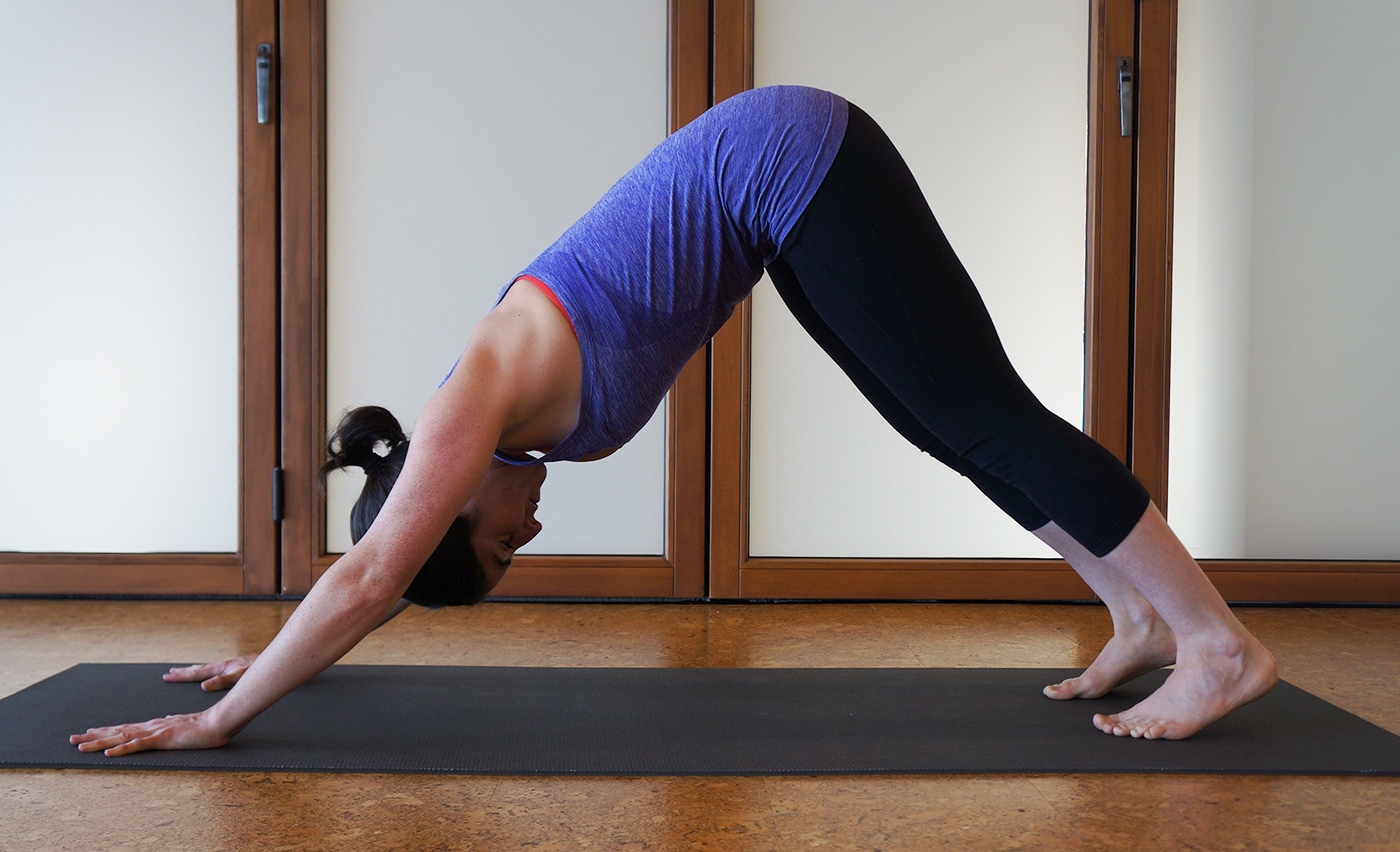
Probably the most recognized pose in yoga, Downdog is considered both a strengthening and resting pose, and is often used to transition or flow between other poses.
Tip from Katie:
Distribute your weight equally between the arms & legs. It’s okay if your heels don’t touch the ground, they may never; let the heels release toward the floor.
If your low back rounds due to tight hamstrings, put a slight bend in your knees.
2. Cobra

The cobra pose is a chest and heart opener, along with a mild back bend that helps lengthen and strengthen the spine.
Tip from Katie:
Be mindful not to overdo it with the back bend. For beginners, a good way to test how high to go is to actually lift your hands off the ground. Use the strength of the back to lift rather than pushing into your hands.
3. Warrior I
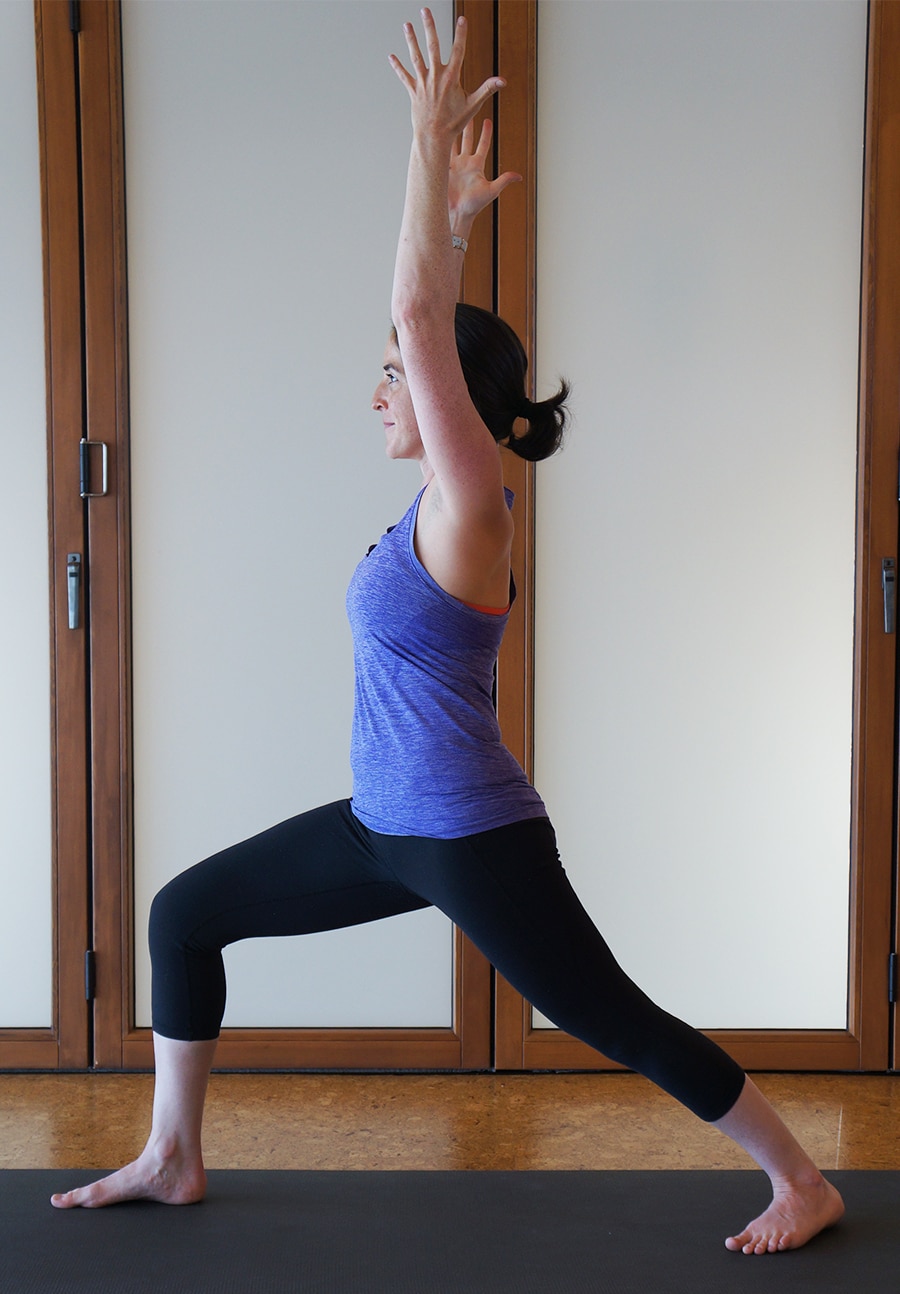
Warrior I is an empowering pose that strengthens and lengthens both the arms and leg muscles.
Tip from Katie:
Place the feet hip-width apart and angle the back toes to point toward the front corner of your mat (not parallel to the back of the mat). Make sure your hips are moving toward squared with the front of the mat, and your front knee stacks directly over your ankle.
4. Warrior II
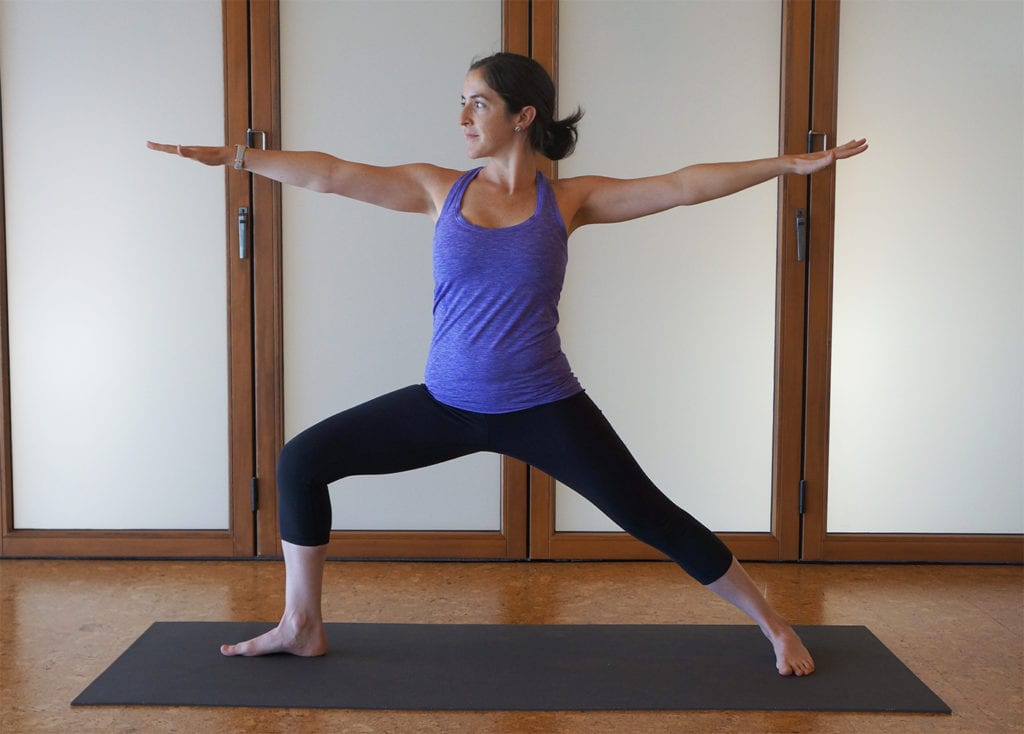
Another full body strengthening and lengthening pose, Warrior II works everything from the ankles to your shoulders.
Tip from Katie:
Just like with Warrior I, keep the bent front knee stacked on top of the ankle and engage your front leg’s glutes so the knee points toward the second toe. Your back foot should be parallel with the back of the mat.
5. Child’s Pose
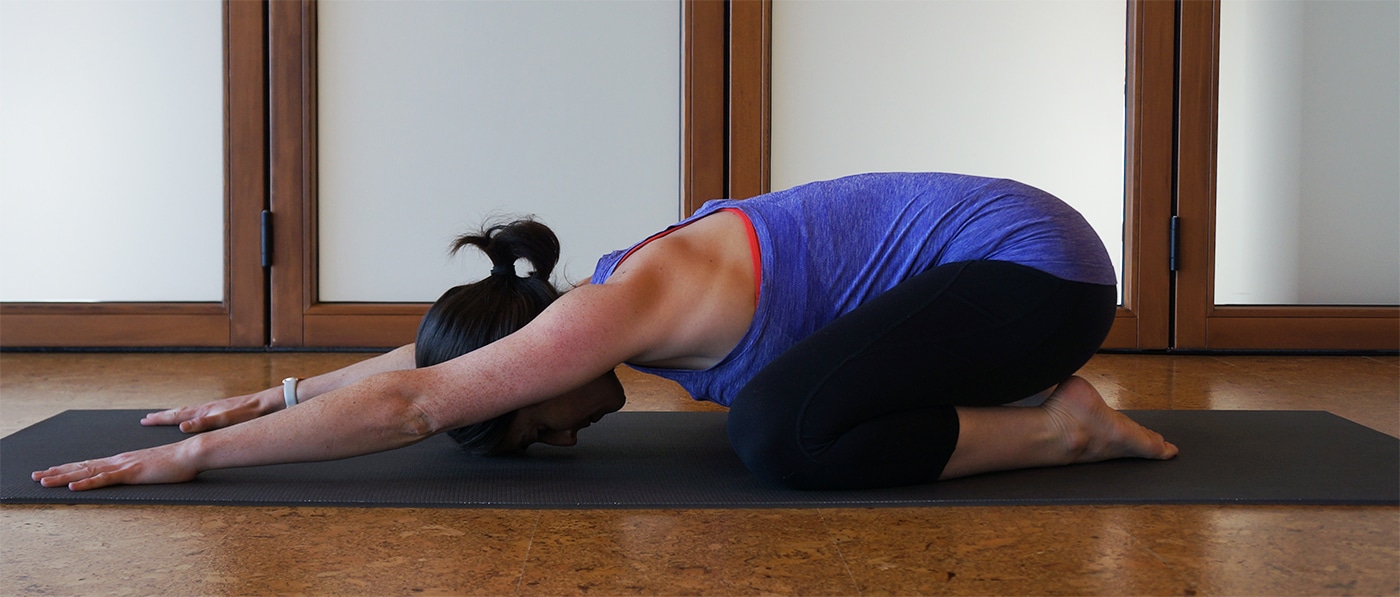
Child’s Pose is a life saver for many new yogis who need a quick rest during class.
Tip from Katie:
Even when it’s not cued by the teacher, never be afraid to drop into child’s pose to rest and restore throughout class. Sometimes it’s just what your mind and body need before moving on to the next flow.
If it is uncomfortable, find another resting posture that feels good and take it when you need it.
VIDEOS: All-Levels Yoga Practices for Runners
Above I said that there are two main ways to incorporate yoga into your training:
- To strengthen and stretch post-run, typically for 15-30 minutes
- For cross-training on off or low-mileage days, with a full-length class at a yoga studio
To help you get started, here are two practices, one for each purpose. There were originally created for Rock Creek Runner’s Next Level Runner program and are taught by Katie.
The first is intended as a post-run strengthening practice:
This second video was just recorded just a few weeks ago. I asked Katie (check out that baby bump!) to lead a friend and me through a full hour long class, focusing specifically on areas of the body runners need help with most. This one is perfect for an additional workout on your cross-training days or as a replacement for an easy run.
Namaste Your Way to Better Running
Lame joke? Sorry.
Between the chanting, Sanskrit, and back bends, it’s easy to be skeptical of (or intimidated by) yoga. Until you try it.
My first class wasn’t pretty — I spent half the time looking at what others were doing — but I enjoyed it. So I tried it again, and again, and suddenly yoga became an important tool for my training.
As vegan ultrarunner Scott Jurek puts it, “Because of my yoga and meditation practice, I’m better able to work through things more positively.”
Which is exactly the type of tool I want in my arsenal.
About the Author: Doug is an ultrarunner, coach, and the co-host of NMA Radio.
Leave a Reply
I know yoga is good for me as a runner…. even though it can hurt more than speed work or a race. I recently got back to trying to go to at least one yoga class a week. Besides helping me improve my flexibility–so important for masters runners like me — It also helps me destress. Great, comprehensive article.
This post makes me so happy! I try to do yoga regularly, and I’m always looking for new classes aimed at runners, so I can’t wait to try these out! Thanks so much to you and Katie!
I can attest to yoga aiding in running first hand. When I trained for my first half marathon, I did nothing but running. I barely walked across the finish line and could not drive the hour home from the race. Thank goodness my husband and all around amazing stuff holder was there with me. I started practicing yoga on a regular basis, at least four times a week, for recovery and kept practicing as I trained for my second half five months later. Not only did I run across that finish line, I PR’d by 6 minutes and drove the hour home! It was amazing and I know that keeping a steady yoga practice helped tremendously. This past June, I ran the Mammoth Half Marathon and was concerned about the elevation and running in it. My goal was to just finish, regardless of time but I ran it with only a 3 minute gain on my prior PR and had zero issues breathing through it. I know that taking Vinyasa classes and learning to breathe through and in asanas had a great deal to do with how I ran at a almost 8k foot elevation change from where I normally run. Yoga and running for me go hand in hand as very different forms of meditation. I know that pacing myself during long runs helps when I take a 108 sun salutation workshop and that learning to breathe through the discomfort of Frog Pose helps me take those cleansing breaths to push through that tough mile or miles when I want to give up.
Thank you so much for this! I regularly struggle with IT band issues yet still want to become a better run and be able to run farther distances; I’ve heard from other runners that yoga has greatly improved their running and so I’ve wanted to try it for myself. I am so excited to try these videos later this week! Thank you!
Nicely done… surely sufficient to inspire some of us to explore yoga!
In my case, running has taken a back seat to interval training and bicycling, but yoga remains an important part of recovery.
Moreover, I’ve developed some routines that incorporate fairly heavy dumb bells into my yoga practice (Ashtanga-oriented) and find that doing this simultaneously gives me the best that yoga and weightlifting have to offer me.
Thank you for sharing! I enjoyed reading the article a lot. I am a yoga practitioner and teacher myself walking that yoga path for almost 30 years now. The yoga concept supported me ever since I started running 2 years ago. Now I am an Ultra Trail Runner and I love sharing my experience with those interested. It is not only about the posture for strength, stability, injury prevention or therapy but also the mental training, breathing and regeneration that is so essential for long distance running. I am convinced it is that balanced mix of strenght, flexibility, breath and fokus that keeps me going and free from injury.
Namaste. Sonja
-
check out power yoga for sports and gwen lawrence yoga on you tube for free yoga for athletes videos
gwen
Wow you say it all Doug. I recently dragged a veteran runner friend to the yoga class I attend twice a week. He is starting to believe as I do that it’s the answer to many runners dreams, just as Doug describes. I’ll be taking Katie’s video with me to Vietnam to help prepare and recover from the mountain marathon.
Namaste Katie and Doug.
Thanks for the sequences. I actually practiced yoga for quite a few years before running. I doubt I would have started to run if I had not gained strength both mental and physical from yoga. I will try out the sequences after a workout soon . It is not uncommon that I figure out during yoga class where I am experiencing tightness that I would not have recognized otherwise. Best wishes on the the upcoming baby ( been trying to catch up on podcasts)! Sending blessings your way ! Namaste
Such a comprehensive article – thankyou so much. I gave up running a long time ago after an injury to my foot – and took up swimming then moved to yoga… and I’m now trying to get back into running after about 4 years… but I feel like my body just doesn’t want to do it again! So will be trying the yoga for runners routine and will report back!
Thanks for a great post! I can speak from experience that yoga takes running to a whole new level. I am basically injury free because of it (before I did yoga, I was just always injured because of running. Well done Doug for a well thought out post, which will hopefully inspire more people to try combining yoga and running!
Thank you so much for these two videos. They are exactly what I needed as a fairly newby runner 🙂
[…] Hay, author at No Meat Athlete, recently put together Yoga for Runners: The Ultimate Guide, where he talks about numerous ways runners can benefit from regular yoga […]




This is an amazing resource for runners. I’m about to write a post on yoga for my blog and will definitely link to this. Yoga can be such a hard activity to adopt when we runners are so accustomed to moving fast and focusing on speed. I always know I’ll enjoy yoga once I get into it, but that first few minutes can be challenging. The few times I’ve been able to stick with a yoga routine, I’ve seen amazing benefits both physically and mentally. Thanks for posting such an in-depth guide to get us started (or restarted!)
Diana
betterthanalive.com